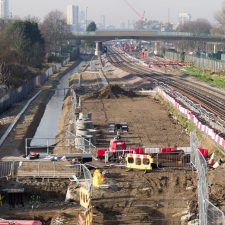Case Study: Wickham Valley Culvert Project at Abbey Wood Station
Main Contractor: Balfour Beatty
Ainsworth Civils worked with main contractor Balfour Beatty on Network Rail’s project to build a new station and two miles of new track in the Abbey Wood area as part of the Crossrail programme. One of the largest railway and infrastructure construction projects undertaken in the UK, Crossrail is a 118km (73 mile) railway line that has been developed for London and the south east.
Along a section of the new Crossrail high-speed tracks, there was a conflict between the new Crossrail alignment leading to Abbey Wood station and the existing course of the Wickham Valley Waterway. The long-hidden River Wogebourne, now known as the Wickham Valley Waterway, begins in Shooters Hill and snakes its way through Plumstead to Abbey Wood before reaching Thamesmead. Most has been progressively covered over the years and there are now few signs of it running above ground.
The culvert had to be safely diverted from the tracks to ensure health and safety standards
The waterway’s close proximity to the new Crossrail high speed tracks meant that 270m of the culvert had to be demolished, moved and rebuilt without interrupting the water flow as there was no possibility of flood mitigation in place due to environmental and cost restrictions. The culvert had to be safely diverted to a pre-agreed distance from the tracks to ensure health and safety standards were met regarding proximity to live tracks.
Due to Ainsworth Civils’ Trusted Supply Chain Partner status with Balfour Beatty, they requested that we undertake all of the demolition and construction works regarding the culvert on their behalf even though this was outside our usual scope of supply. Ainsworth Civils had never undertaken a project of this nature before and we immediately set about learning how to install a culvert in live flow conditions. We researched how it would be possible to build a culvert under these specific conditions and how to develop unique bypass channel solutions.
We sought to maintain the flow by installing a diversion pipe while simultaneously working around the numerous existing services. Once this was in place, we proceeded to mechanically break into the culvert and divert the water through the diversion pipe.
Our research with the client led us to three possible solutions:
- An off-line simple in-situ concrete channel with final connections, which was not achievable due to earlier project delays and the speed of construction required and access to the area.
- An off-line heavy duty piled and suspended precast solution, which was not achievable due to its significant costs, exceeding £20m.
- An on-line solution with the installation of a bypass channel and the subsequent safe demolition of the culvert next to the live rail, taking care to avoid a landslip and undermining the existing rail lines.
The third solution, while complex, was most cost effective overall, resulting in it being selected for implementation.
Any errors at this stage could easily have led to astronomical cost and time delays to the overall project, as well as health and safety concerns that would inevitably have brought about catastrophic business-ending consequences. Site restrictions also included a narrow site profile due the close proximity of the adjacent road to the rail lines. We therefore had to work carefully between these two enforced boundaries to ultimately move the culvert half a metre from its original position.
The works commenced with the installation of an adequately sized bypass channel. We selected a 600mm diameter pipe as this would take the flow in normal conditions but not flooding conditions. For flooding conditions, we installed a weir in the channel and the works would be abandoned to allow the flood water to pass. To make this workable from an Environmental Protection point of view we ensured that the excavated channel was clear and blinded at the end of every shift to prevent environmental contamination, should heavy rain and flooding occur over night.
We then sheet piled either side of the existing culvert. A Movac self-erecting low vibration piling unit was selected to undertake the sheet piling works. We excavated around the existing culvert and demolished it in sections while simultaneously pouring a concrete plug to prevent the sheet piles from collapsing inwards due to the ground pressure from the mainline railway tracks and the adjacent road. This concrete plug also served to seal off the ground and prevent environmental erosion in flood conditions.
Specially designed and sized precast culverts were installed to form the newly aligned culvert
Specially designed and sized precast culverts were installed to form the newly aligned culvert. The joints between the precast segments had a seal added between each segment and again over the tops and sides to prevent water egress from above. We specially fabricated a new curved roof section of permanent formwork to complete the culvert where it curved round to meet the original route. These sections could not be fabricated as precast units due to the bespoke curve and we had to design and fabricate suitable radiused shutters to form a matching culvert and suitable roof to take the train derailment loads.
The project was successfully constructed and delivered, all enabled through a careful process of researching and designing a workable solution. This research and design development led to massive cost savings for the client and the safe on-time delivery of a valuable infrastructure asset for Crossrail.


